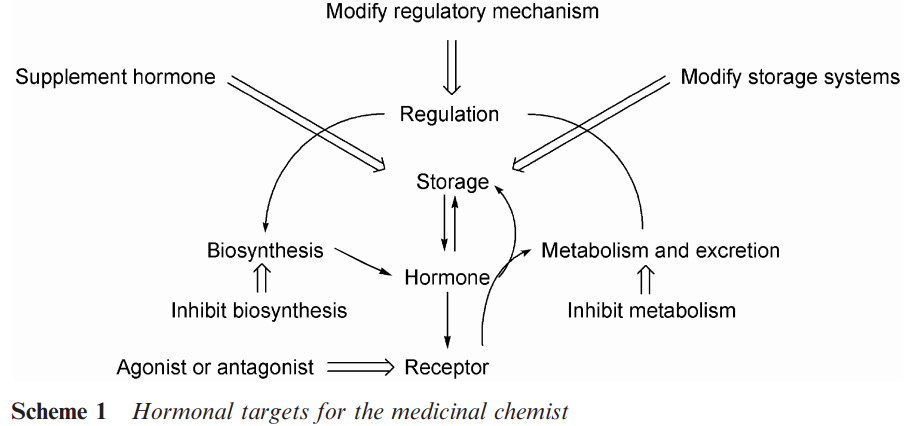


 علم الكيمياء
علم الكيمياء 
 الكيمياء التحليلية
الكيمياء التحليلية 
 الكيمياء الحياتية
الكيمياء الحياتية 
 الكيمياء العضوية
الكيمياء العضوية 
 الكيمياء الفيزيائية
الكيمياء الفيزيائية
 الكيمياء اللاعضوية
الكيمياء اللاعضوية 
 مواضيع اخرى في الكيمياء
مواضيع اخرى في الكيمياء
 الكيمياء الصناعية
الكيمياء الصناعية |
Read More
Date: 4-10-2017
Date: 16-5-2017
Date: 4-10-2017
|
TARGETS FOR THE MEDICINAL CHEMIST
Hormones as Targets
The body produces substances known as hormones, which regulate body functions. These can be circulatory hormones such as the steroid 2 Chapter 1 and peptide hormones. They are produced by one organ and are then transported to their target organ. Others, such as histamine are local hormones, which are produced by one cell and have their action on adjacent cells. These are sometimes known as autocoids. The third group are the neurotransmitters, which are formed and have their action at nerve endings. A fourth group are the ‘second messengers’. These are compounds that are formed within a cell often as a result of an external stimulus via a trans-membrane protein. They control the function of various enzyme systems within the cell. Many hormones and neurotransmitters exhibit their cell-signalling biological activity by binding to a receptor on a cell surface. The receptor may be part of a trans-membrane protein, which crosses the cell wall. This binding to a trans-membrane protein then initiates a sequence of events within the cell. Other hormones have to cross the cell wall and exert their biological activity by binding to nuclear receptors within the cell. This activates the nucleic acids and initiates the DNA– RNA–protein sequence of events. The hormones are biosynthesized by a series of steps and once they have produced their biological effects, they are metabolized and excreted. The medicinal chemist may interact with this sequence in a number of ways. The chemist may synthesize the biological compound itself and use it to correct a deficiency or an agonist may be prepared. An agonist is a relative of the naturally occurring substance that also binds to the receptor and elicits the same biological effect. A partial agonist is a compound, which binds but does not elicit the full response. In contrast to this an antagonist binds to the receptor site but does not produce the biological effect. It may block the effect of an agonist. Often agonists and antagonists have quite similar structures for both have to bind to the receptor. The enzymes which mediate the biosynthesis of the naturally-occurring compound may be inhibited by a drug. Hence the hormone will not be formed and its biological effect will not be observed. Many enzymes are regulated by a metabolite from a later stage in the biosynthetic pathway. This type of feedback regulation may be used to moderate the amount of biosynthesis that occurs. The release of a compound from storage may also be a regulatory step. When enzyme systems are targets for drugs, the binding may be of a competitive and reversible nature or it may be irreversible. Sometimes the product of the reaction of the enzyme with an artificial substrate may then react with the enzyme itself preventing the enzyme from catalyzing further transformations. This type of inhibition is known as suicide inhibition.
Once a hormone or neurotransmitter has completed its biological function, it may be metabolized and excreted or it may participate in the Introduction 3 feedback regulatory mechanism associated with its formation.

If these later metabolic steps are inhibited, the action of the hormone may be prolonged. The re-uptake of a neurotransmitter may form part of the regulatory mechanism. Interferance with the re-uptake mechanism may also prolong the action of the neurotransmitter. These targets are summarized in Scheme 1.



|
|
|
|
"عادة ليلية" قد تكون المفتاح للوقاية من الخرف
|
|
|
|
|
|
|
ممتص الصدمات: طريقة عمله وأهميته وأبرز علامات تلفه
|
|
|
|
|
|
|
ضمن أسبوع الإرشاد النفسي.. جامعة العميد تُقيم أنشطةً ثقافية وتطويرية لطلبتها
|
|
|